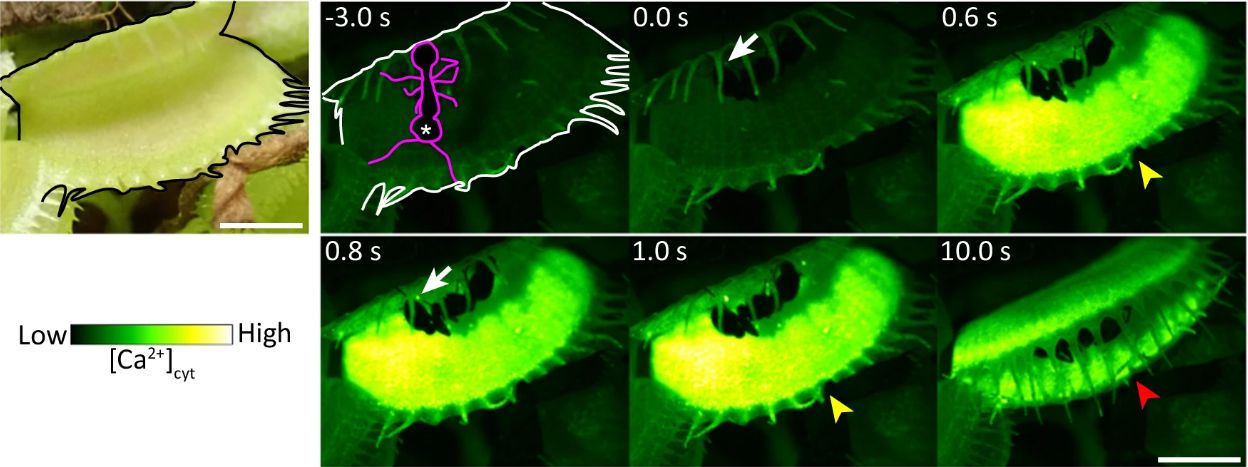Science
New Study Uncovers Mechanism Behind Venus Flytrap’s Quick Reflexes

Research published in Nature Communications has unveiled the mechanism that allows the Venus flytrap (Dionaea muscipula) to react with remarkable speed to potential prey. This breakthrough, led by researcher Hiraku Suda and colleagues, provides insights into the plant’s unique sensory capabilities, which have fascinated scientists for years.
The Venus flytrap employs specialized sensory hairs on its leaves to detect movement. These hairs utilize calcium threshold signals to respond to specific stimuli. While the general function of these sensory hairs was understood, the precise biological mechanism remained largely unexplored until now. The study identifies a mechanosensor known as DmMSL10, which is crucial for the plant’s rapid response to touch.
To investigate this mechanism, researchers created a variant of the Venus flytrap that lacked the DmMSL10 channel, a stretch-activated chloride ion (Cl–) channel responsible for generating electrical signals. Comparing the wild-type plants with the knockout variant, the team discovered significant differences in response rates. In the wild-type plants, mechanical stimulation of the sensor hairs resulted in sustained action potentials, allowing the plant to continue reacting even after the initial stimulus was removed. Conversely, the knockout variant displayed a much lower rate of action potential generation.
In a series of experiments, ants were allowed to wander across the leaves of both the wild-type and knockout plants. The wild-type plant successfully captured the first ant that landed on its leaf, while the knockout variant showed no reaction, failing to propagate the necessary calcium signals to trigger closure. This stark contrast underscores the importance of DmMSL10 in prey detection.
This discovery not only enhances our understanding of how D. muscipula captures its prey but also opens avenues for further research into similar mechanisms in other carnivorous plants, such as the waterwheel plant (Aldrovanda vesiculosa) and D. glanduligera, which exhibit comparable rapid responses. The findings may also shed light on the evolutionary parallels between plant and animal mechanosensors.
In summary, the research highlights the intricate biology of the Venus flytrap, emphasizing how the DmMSL10 mechanosensor enables this extraordinary plant to detect and capture its prey efficiently. As scientists continue to explore these mechanisms, the potential for discovering further evolutionary insights into plant behavior remains promising.
-

 World5 days ago
World5 days agoExposing the Reality Behind Guatemala’s Garment Industry
-

 Politics5 days ago
Politics5 days agoLB Pharmaceuticals Quiet Period Ends October 21, Analysts Weigh In
-

 Business5 days ago
Business5 days agoRoyal Bank of Canada Upgrades Ovintiv to Outperform Rating
-

 Sports5 days ago
Sports5 days agoSaquon Barkley Reflects on James Franklin’s Dismissal from Penn State
-

 World5 days ago
World5 days agoHamas to Return Remains of Additional Hostage on Friday
-

 Health5 days ago
Health5 days agoFDA Announces First Nine Recipients of National Priority Vouchers
-

 Science5 days ago
Science5 days agoMIT Develops 3D Brain Models from Patient Cells for Custom Therapies
-

 Entertainment5 days ago
Entertainment5 days agoOlivia Nuzzi’s Memoir Set to Uncover RFK Jr.’s Controversial Texts
-

 Lifestyle3 days ago
Lifestyle3 days agoHistorian Seeks Help to Uncover Cherry Street’s Past
-

 Science3 days ago
Science3 days agoYale School of the Environment Launches Accelerated Master’s Programs
-

 Entertainment5 days ago
Entertainment5 days agoSylvester Stallone’s ‘Alarum’ Surges in Streaming Despite Poor Reviews
-

 Lifestyle5 days ago
Lifestyle5 days agoSouth Los Angeles Intersection Renamed to Honor Activist Danny Bakewell Sr.









